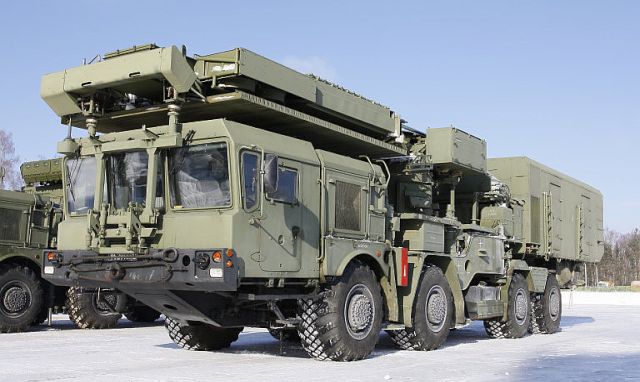IDN TAKE: S-400 Triumf a Game Changer for India

Almaz-Antey S-400 Triumf
India has shown interest in
acquiring the advanced and versatile S-400 Triumf Air Defense System
from Russia. In October 2015, it was reported that India's defence
acquisition committee was set to clear Indian Air Force proposal of
buying 12 S-400 systems.
The S-400 SAM family is one of the most advanced and capable operational
SAM systems in the world today. The Almaz-Antey S-400 Triumf or NATO
Reporting Name: SA-21 Growler system is the most recent evolution of the
S-300P family of SAM systems, initially tested in 1999. The S-400 is a
long-range, mobile strategic SAM system. The system has been produced in
numerous variants, and remained in production for export in late 2009.
The successor system, the S-400 Triumf, is largely an evolution of the
S-300P series, and is now entering the export market. At least one
report claims that funding for the development of the Triumf was
provided in part by China. The principal distinctions between the S-400
and its predecessor lie in further refinements to the radars and
software.

From its genesis during the 1970's this former Soviet PVO system has
continuously evolved, through a series of incremental and larger
enhancements. At this time the China is the largest single user of this
family of weapons, after the Russian Federation which inherited the
considerable inventory operated by the Voyska PVO.

91N6E Big Bird Phased Array Acquisition and Battle Management Radar carried by an MZKT-7930 vehicle
While the S-300P/S-400 series is often labelled as 'Russia's Patriot',
the system in many key respects is more capable than the US Patriot
series, and in later variants offers mobility performance and thus
survivability much better than that of the Patriot. The Patriot system
is in reality a pitiful semblance of Russia's S-400 Air Defense System.
The introduction of the 64N6 Big Bird series of phased array acquisition
radars in later variants provides them with many of the capabilities of
the US SPY-1 Aegis system, in a highly mobile SAM system.
An S-400 battery has three kinds of missiles, each intended to engage
aerial targets at different ranges. The longest ranged SAM can engage at
400km, with shorter-ranged missiles compensating with enhanced
capabilities for killing fast, maneuverable targets. The S-400 can also
engage ballistic missiles.
Rapidly deployable, high survivable, and highly lethal, these weapons
are especially difficult to counter and require significant capabilities
to robustly defeat. With superb missile kinematics, high power-aperture
phased array radar capability, high jam resistance and high mobility,
the S-400 system would change the character and duration of air war
campaigns. It can be launched against AWACS, J-STARS, EA-6B support
jammers and other high-value targets. The US Air Force currently
envisages the F-22A Raptor as the primary weapon used to defeat these
capable systems.

The S-400 was developed by the Almaz-Antey corporation. It uses multiple
missile variants to shoot down stealth aircraft, UAVs, cruise missiles
and sub-strategic ballistic missiles. Its operational range for
aerodynamic targets is about 250 km and for ballistic targets 60 km. The
S-400 can engage up to 36 targets simultaneously.
INTERCEPTORS
The S-400 uses the 48N6 and 9M96 missiles to intercept ballistic missiles. The 48N6DM was reported to be specifically designed for S-400. In July 2012, a new missile designated 40N6 with a range of up to 400 km passed state trials. Russia’s Air and Missile Defense Command Chief-of-Staff Major General Andrei Demin said, the missile will be delivered “Soon”.
The S-400 Triumph also launches 9M96E and 9M96E2 medium range ground-to-air missiles. Designed for direct impact, the missiles can strike fast moving targets such as fighter aircraft with a high hit probability. The maximum range of the 9M96 missile is 120km.

77N6-N Missile Launch Cannister
Two new missiles are under development for the S-400: the 77N6-N and the
77N6-N1. They were reported to be capable of direct engagement with
targets flying at hypersonic speeds (seven kilometers per second).

Brand New 77N6-N & 77N6-N1 Missiles at an Integration Rig
Igor Ashurbeili, former Almaz-Antey Central Design Bureau General
Director, called the S-400 “a truly high-technology product with major
export potential.” In spite of the high interest in S-400 from abroad,
Russia has not started exporting it yet. First, Rosoboronexport said,
domestic demand needs to be satisfied.
CONCLUSION
Introduction of the S-400 system will be a game changer for India, and
thankfully and finally a equitable balance will fall into place since
China has also decided to introduce this system.
Conventional unstealthy, or partially stealthy combat aircraft will have
difficulty surviving within the coverage of the S-400 systems - the
high transmit power, large radar and missile seeker apertures, low
sidelobes, generous use of monopulse angle tracking and extensive ECCM
features make these systems difficult to jam effectively. (Adapted from the works of Dr Carlo Kopp and Peter Goon and other Internet Sources)



No comments:
Post a Comment